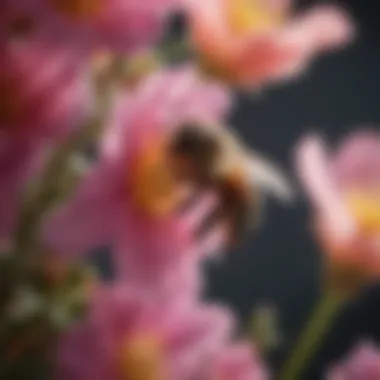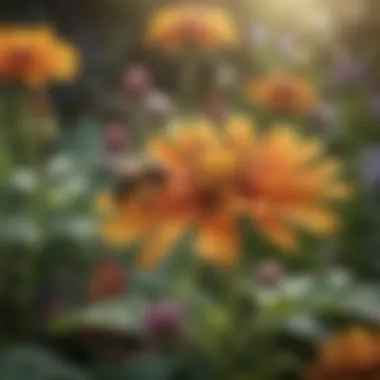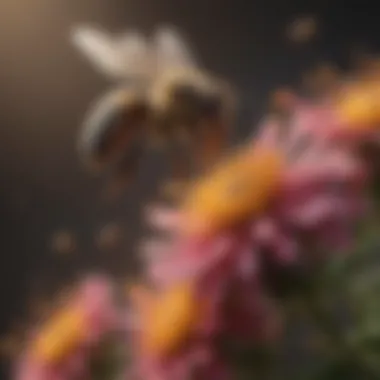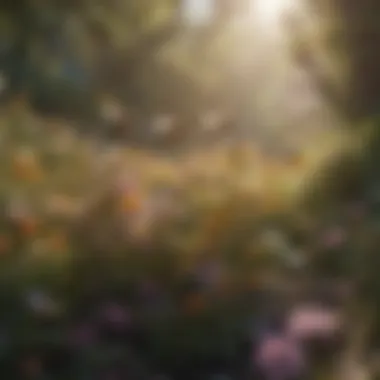The Vital Connection Between Bees and Flower Reproduction


Intro
The interaction between bees and flowers plays a crucial role in ecosystems globally. This relationship not only ensures the survival of various plant species but also helps maintain biodiversity. Understanding how bees contribute to flower reproduction reveals the complexity of nature and the delicate balance that sustains our environment.
Pollination is the primary means through which bees transfer pollen from the male parts of flowers to female parts, allowing for fertilization and seed development. This service provided by bees is foundational for numerous plant types and affects a range of ecological processes. The viability of agricultural systems and the lushness of our gardens largely depend on healthy bee populations and their abilities. Recognizing the significance of this interaction invites a deeper exploration into the factors that foster or hinder bee populations today.
The Pollination Process
Pollination involves several stages. First, bees collect nectar and pollen as a food source, visiting diverse flowers during this process. Their physical structure, with body hairs designed to capture pollen, allows easy transfer as they move from bloom to bloom.
Critically, different flowers attract different bee species based on scent, color, and shape. For instance, blue and purple flowers tend to attract specific bee types better than others. This relationship evolves, with flowering plants adapting features that specifically attract bees best equipped for their reproduction success.
“Bees are responsible for the pollination of more than one-third of the world’s food supply.” — National Geographic
Ecological and Biological Implications
Evolutionary Advantages
This relationship extends beyond mere survival; both flowers and bees have evolved traits that provide mutual benefits. Flowers have developed colors, scents, and nectar types that are optimized to attract specific bee species. On the other hand, bees that can efficiently retrieve nectar from certain flowers have advantages for survival and reproduction. This interdependence fosters stronger probiotic populations, enhances flowering biodiversity, and encourages diverse ecosystems.
Ecosystems and Biodiversity
Bees support not only individual plants but entire ecosystems. A variety of plants generate a stable environment by creating habitats for other species. If bee populations decline, it leads to less pollinization, fewer flowering plants, and ultimately a drop in species that depend on those plants for food and shelter. Understanding the broader environmental impacts is crucial in addressing the dangers looming over bee populations.
End
The integral synergy between bees and flowers illustrates the interconnectedness of life on Earth. Each phase in the process of pollination contributes significantly, from enhancing biodiversity to boosting agricultural productivity. Protecting bee populations is paramount. A resilient ecosystem thrives on healthy bee populations, which in turn sustains plant life.
Going forward, awareness and action are needed to ensure this partnership endures. Knowing the value of such relationships is a step towards restoring and preserving balance in our natural world.
Foreword
In the complexities of nature, few relationships hold the weight of that between bees and flowering plants. Pollination emerges as a pivotal process in sustaining plant life, ensuring reproductive success of flowers. The ongoing dialogue between bees and flowers highlights an essential dynamic that fosters ecological balance. Understanding this interplay not only illuminates the elegance of plant evolution but also underscores systemic ecological functions that contribute to biodiversity.
The significance of bees extends beyond mere pollination. These insects support over 80% of flowering plants, making their role singularly important in the ecosystem. A world without bees would diminish the vibrancy of nature, leading to a decline of both flora and fauna, ultimately affecting human sustainability.
Moreover, the intricate relationships are not absolute; they evolve based on environmental changes and behavioral adaptations. Recognizing nuances in this dependency helps appreciate the complexity of biological systems. The consequences of declining bee populations ripple through ecosystems, emphasizing the urgent need for conservation efforts.
In essence, this article will delve into diverse aspects surrounding the role of bees in pollination, present an evolutionary perspective, and explore socio-economic implications tied to these pollinators. We will initiate with an in-depth review of the pollination process, setting the foundation for understanding how bees and flowers coexist in a delicate yet robust equilibrium. Engaging with these concepts enhances awareness of a captivating yet critical humorless journey that sustains life on earth.
Understanding Pollination
Pollination is a fundamental process that enables flowering plants, or angiosperms, to reproduce. Recognizing its significance allows us to appreciate the integral relationship between flowers and bees. This section discusses the scientific, ecological, and evolutionary importance of understanding pollination, with an emphasis on its various forms and mechanisms.
Pollination is vital for promoting plant diversity and ecosystem health. Many plants rely on animals, particularly bees, to facilitate this process. When bees visit flowers, they unknowingly transfer pollen from one floral structure to another, leading to fertilization. This process has far-reaching implications for biodiversity, agriculture, and food security, underscoring its importance in our ecosystems.
Definition of Pollination
Pollination is the act of transferring pollen from the male part of a flower (anther) to the female part (stigma) of the same or another flower. It is a prerequisite for fertilization, where the male gametes unite with female ovules to form seeds. The successful completion of this process is essential for propagating many plant species.
Pollination can vary greatly among species, reflecting adaptations that favor survival and reproductive success. Plants have evolved intricate strategies to ensure efficient pollen transfer, leading to variations in floral design, scent, and nectar availability which attracts pollinators like bees.
Types of Pollination
Pollination can be broadly classified into two main types: self-pollination and cross-pollination.


Self-pollination
Self-pollination occurs when a flower's pollen fertilizes its own ovule. This process allows plants to reproduce without the need for external pollinators. A significant aspect of self-pollination is its reliability, especially in isolated environments where pollinators are scarce.
Some key characteristics make self-pollination beneficial. Most notably, it ensures that plants can proliferate in conditions where crosses with other flowers are limited.
However, self-pollination also poses a disadvantage. It limits genetic diversity, as offspring are more genetically similar to their parent plants. This can impact a population's ability to adapt to changes in the environment, potentially leading to vulnerability in circumstances such as climate shifts.
Cross-pollination
Cross-pollination involves the transfer of pollen from one flower to another flower of the same species. This type is prominent in angiosperms and depends heavily on external pollinators like bees, birds, or wind.
A key characteristic of cross-pollination is its promotion of genetic diversity. By involving several parent plants, cross-pollination generates a wide range of genetic combinations, enhancing the chances of adaptability.
One unique feature of cross-pollination is that it often yields more vigorous offspring compared to those produced through self-pollination. This advantage helps maintain population resilience and can aid in the rapid re-colonization of an area affected by disturbances such as fire or drought.
However, cross-pollination also presents challenges, as it requires specific interactions with pollinators and dependency on them. If pollinator populations decline, the ability for cross-pollination diminishes, leading to more reliance on self-pollination mechanisms, which could weaken the genetic health of plant populations.
The Role of Bees in Pollination
Pollination is a critical process in the reproductive cycle of plants, and bees significantly contribute to this System. Their role goes beyond just the transportation of pollen; it embraces intricate relationships formed over millions of years between flowers and bees. This symbiotic partnership enhances the reproductive success of flowers and secures food supplies for bees. With the decline of bee populations, understanding this relationship becomes essential.
Bees as Primary Pollinators
Bees are known as primary pollinators due to their high efficiency in transferring pollen between flowers. Different species of bees, such as honeybees (Apis mellifera) and bumblebees (Bombus spp.), show found diverse behavior related to pollen collection and transfer. The extensive foraging patterns exhibited by bees make them particularly effective in pollination.
To understand their significance in the ecosystem:
- Diversity of Pollen Sources: Bees often visit multiple flowers during their foraging trips. This increases genetic diversity among plants, leading to robust and resilient plant populations.
- Increased Crop Yields: Research shows that crops like almonds, berries, and pumpkins yield more when serviced by bee pollination. Details suggest a measurable increase in fruit and seed quality, making their role paramount in food production.
- Natural Ecosystems Contributions: Bees support not only agricultural systems but also contribute to natural ecosystems. They aid the reproduction of wild plants that form the basis of numerous food webs.
Consequently, conserving bee populations is vital. As key players, their presence ensures sustainable agricultural practices and the health of our environmental system.
Mechanisms of Pollination by Bees
The mechanisms by which bees pollinate flowers are both fascinating and essential for the success of plant reproduction. The process is driven by the innate behavior of bees and the anatomical features that facilitate efficient pollen transfer.
- Electrostatic Forces: Bees have tiny hairs on their bodies that help collect pollen grains. When they visit flowers, the static electricity generated allows sticky pollen to adhere to their bodies.
- Foraging Behavior: Bees exhibit foraging techniques that are systematic and intentional. They tend to favor certain flower types based on profitability, ensuring a more successful pollen transfer per visit.
- Specialized Mouthparts: The long tongue of bees is adapted to reach deep into flowers, gathering nectar. While doing this, their bodies brush against the reproductive parts of the flower, facilitating pollen exchange.
Through these interactions, bees operate as vital agricultural instruments, stimulating growth in a diverse range of plants.
Understanding these mechanisms offers insight into more sustainable practices for enhancing bee habitats and employing measures to safeguard their populations for the future.
Evolutionary Adaptations of Flowers
The evolution of flowers has shaped their relationship with bees, thereby influences the ways plants reproduce. Various adaptations have become essential in maximizing successful pollination. Flowers have developed traits that draw bees and other pollinators, optimizing both quantity and quality of fertilization. Understanding these adaptations highlights the mutual benefits received by both manners.
Flower Traits and Bee Attraction
Color and scent
Color and scent are crucial factors attracting bees to flowers. Bright colors like purple and yellow signal to bees that a flower is ready for pollination. Many bees have excellent vision and can see ultraviolet light, which makes certain patterns on flowers more attractive, guiding bees directly to their nectar. The scent of flowers also plays a significant role. Some scents serve to allure specific types of bees. The inherent sweet fragrance is appealing and signals a reward for visiting. However, the scent must not be overpowering as it could repel certain species.
A key characteristic of color and scent is their dual role; they distinguish one flower from another and can influence the type of bee that visits. For example, flowers with sweeter nectar attracts species that are more productive in pollination. The disadvantage is that too much reliance on these attributes can risk being less visible to cross-pollinators.
Nectar production


Nectar production acts as a reward to bees for their pollination efforts. It is rich in sugars and provides bees with energy. Nectar serves as a direct incentive for bees to visit certain flowers, ensuring not only pollination of that flower but assisting in more extensive fertilization across plants. Most flowers produce nectar abundantly during peak blooming periods aimed at synchronizing the times bees are most active.
A critical characteristic of nectar production is the significance of its availability. When flowers produce higher quantities of nectar, it increases the likelihood of attracting more bees, facilitating extra successful pollination events. However, variations in nectar concentration among different flowers may turn some bees away, potentially impacting pollination success for less concentrated flowers.
Co-evolution of Bees and Flowers
The interaction between bees and flowers is a prime example of co-evolution. This phenomenon has led to specific mutual adaptations over time. As bees develop unique traits to collect nectar or pollen more effectively, the flowers tone down characteristics that assist in further attraction and reproduction. This results in a harmonious relationship, reinforcing the intricate balance in ecosystems welcoming biodiversity and natural sustainability. Understanding the nuances of this co-evolution helps emphasize why bees play such an integral role in flower reproduction.
Ecological Importance of Bees and Flowers
The relationship between bees and flowers represents a compelling and vital aspect of our ecosystem. The interdependent nature of this relationship illustrates the complexity of ecological systems. In this section, we explore the significant ecological implications of bees and flowers working together, detailing how their alliance contributes to both biodiversity and the overall stability of habitats.
Impact on Biodiversity
Bee pollination plays a pivotal role in maintaining biodiversity. A diverse range of floral species depends on bees for reproduction. In fact, nearly 75% of the world’s flowering plants rely on some form of pollination, significantly enhancing ecological stability. By facilitating the reproduction of different plant species, bees help prevent the dominance of invasive species. Healthy flower diversity ensures varied habitats for insects, birds, and mammals, promoting richer ecosystems.
Biodiversity directly linked to bee activity promotes resilience, providing ecosystems with the ability to recover from disturbances.
- Floral variety: Different types of flowers attract various bee species, each contributing to pollination. This activity encourages not only the survival but also the flourishing of diverse plant communities.
- Habitat creation: As plants reproduce and thrive, they form essential habitats for various creatures. Rich floral environments thus support entire food webs.
- Genetic diversity: Increased flower types encourage cross-pollination, enhancing the genetic variability among plants. This genetic flow is essential for adaptation and resistance against diseases.
Diminishing bee populations directly threatens these complexities, placing many ecosystems at risk of imbalance, even leading to extinction for some yea species.
Contribution to Food Production
The alliance between bees and flowers is fundamentally important for world food production. As primary pollinators, bees influence the yields of many crops. About one-third of what we eat relies on bee pollination, including fruits, nuts, and vegetables. They enhance the quality and amount of food produced, directly impacting human nutritional sources.
Among the crops significantly benefiting from bee pollination are:
- Apples
- Almonds
- Blueberries
- Tomatoes
Bees termed as “keystone species” for agriculture emphasize their crucial position in the food supply chain. As bee populations decline, prices for pollinator-dependent yields may rise, leading to increased food scarcity.
Additionally, a strong link exists between bee health, sustainability in farming practices, and food security. Sustainable approaches to agriculture and farming greatly support bee populations, ensuring healthier crop production.
Consequences of Bee Population Decline
The decline of bee populations carries significant consequences for both flora and fauna. Bees play a vital role in energizing ecosystems through their pollination service. When their numbers decrease, various environmental ramifications follow. This section examines how diminished bee populations threaten plant reproduction specifically and explore the wider environmental effects that may arise from this issue.
Threats to Plant Reproduction
The partnership between bees and flowering plants is essential for successful plant reproduction. Many crops and wild plants depend on bees for pollination. When bee populations decline, some of the primary impacts on plant reproduction become evident:
- Reduced pollination rates: Without sufficient bee activity, plants cannot receive the required pollen. This lack can lead to fewer seeds formed, thereby jeopardizing the future generation of plants.
- Decreased genetic diversity: Cross-pollination ensures genetic variability in plant populations. As bee numbers decrease, plants may rely more on self-pollination, which limits genetic exchange. This can weaken populations, making them more susceptible to pests and diseases.
- Struggling fruits and vegetables: Many economically important crops such as almonds, blueberries, and cherries directly rely on bee pollination. A decline in their populations threatens the yields and quality these crops provide.
These facets show that the loss of bees endangers not only individual species of plants but also disrupts entire ecosystems.
Wider Environmental Effects
Bee population decline extends beyond mere plant reproduction; it sets off a series of cascading environmental effects. Here are key points to consider:
- Imbalance in food webs: Plants are the cornerstone of food webs. The reduction of flowering plants due to insufficient pollination destabilizes dependent organisms, including herbivores and, subsequently, predators.
- Loss of habitat: Many animals rely on flowering plants for nutrition and shelter. A decline affects biodiversity, ultimately leading to habitat loss across numerous ecosystems.
- Impacts on soil quality: Flowering plants play crucial roles in stabilizing soils. Reduced plant cover increases soil erosion and can degrade land quality.
A single loss reverberates through the environment, impacting communities far from the direct action, thus revealing the intricate connections within ecosystems.
These combined effects illustrate that the decline of bee populations poses serious challenges, not only for floral reproduction but also sustainably for diverse environments.


By recognizing and understanding these consequences, stakeholders can better appreciate the urgency of halting bee population declines and protecting our vital ecosystems.
Conservation Efforts for Bees
Conservation efforts for bees hold great significance in the realm of flower reproduction and ecosystem health. Recognizing the essential role bees play in pollination, these initiatives focus on safeguarding habitats, promoting biodiversity, and ensuring sufficient resources for bee populations. In this section, I will discuss the necessity of such measures, outlining specific sustainable practices and the importance of community involvement and education.
Sustainable Practices
Sustainable practices are key to protecting bee populations. Implementing these in agricultural and urban settings can enhance bee habitats. The measures often include:
- Organic Farming: Reducing or eliminating the use of pesticides and herbicides preserves bee health and promotes better crop pollination.
- Flowering Plant Diversity: Increasing the variety of plants by incorporating native flowers in gardens ensures bees have access to a range of nectar and pollen.
- Beekeeping Practices: Adopting responsible beekeeping techniques can aid in keeping bee colonies healthy while also raising public awareness.
- Habitat Restoration: Restoring degraded ecosystems to create environments conducive to bee populations nurtures biodiversity.
These practices not only support bees but also result in higher crop yields and improved ecosystem dynamics, proving beneficial for both horticulturists and natural ecosystems.
Community Involvement and Education
Communities play an integral role in bee conservation through involvement and education. Elevating public awareness can ensure that people understand why bees are essential. Some strategies include:
- Local Workshops: Hosting community gardens and workshops on how to ward off harmful chemicals effectively will bring people together and increase knowledge.
- Citizen Science Projects: Allowing individuals to monitor bees' activity fosters a connection to nature and provides valuable data that contributes to research.
- School Programs: Incorporating pollinator education into school curriculum will create future stewards of the environment.
- Social Media Campaigns: Using platforms like Facebook and Reddit to disseminate information about bees can broaden awareness and mobilize action.
- Involving the community establishes a shared responsibility, forging stronger connections between people and the environment.
Education and community participation are paramount. Efforts not only promote bee protection but also cultivate a deep-seated appreciation for the integral role they play in flower reproduction and biodiversity. By aligning sustainable practices with grassroots movements, a powerful and informed community can emerge to conserve bee populations effectively.
Ultimately, every little effort makes a significant difference in sustaining the valuable relationship between bees and flowers. It emphasizes that without active participation and sustainable action, the dire threats bees face could jeopardize not only their existence but the very fabric of our ecosystems.
Epilogue
In the intricate web of life, the bond between bees and flowers stands out as a marvel of ecological symbiosis. This article highlights the crucial role that bees play in flower reproduction and the broader impacts on biodiversity. Flowers need bees; this connection is fundamental not only for individual species but also for entire ecosystems.
Understanding the Relevance
Bee pollination ensures genetic diversity among flowering plants. This process strengthens plant populations, making them more resilient to disease and climate fluctuations. The interdependence of bees and flowers can thus be seen as a cornerstone to sustianing lively and rich ecosystems.
Moreover, the impacts transcend ecological health; they reach into agricultural spheres. Many crops that humans depend on for food are pollinated and improved thanks to this relationship. When bees thrive, so does food security.
Considerations for the Future
However, bee population declines pose significant threats to this well-established system. It is imperative to recognize the nuances involved in such interactions. Protecting bees means safeguarding our floral resources as well as our food productions. Without encouragement of sustainable practices, unnoticed consequences begin to manifest sharply in both nature and agriculture.
To conclude, the role of bees in the overall fertility of flowers cannot be overstated. This partnership not only enriches biodiversity but sustains essential life processes inherent in biological landscapes. As we reflect back upon the importance of this species, we must apply learned knowledge to preservation efforts to ensure both flowers and their tiny allies continue to flourish.
"In many ways, bees symbolize the most profound relationships in nature, demonstrating how interconnected our world truly is."
By understanding these dimensions and exploring them together, stakeholders across various fields – from luxury travel curators to fine dining consultants – can participate in saving this foundational link in nature. A thriving natural environment serves as the backdrop for creating memorable experiences, thus illuminating the connections between ecological integrity and high-end lifestyles.
Further Reading and Resources
Exploring the topic of the role of bees in flower reproduction provides insights into a complex and vital system. Understanding this relationship extends beyond the basic principles discussed in the article. Further reading and resouces serve to enrich your knowledge and provide additional layers of context.
Research literature and public publications delve deeper into the mechanisms of pollination. They explain nuances in how different bee species interact with various flora. Technical journals, such as those from the American Association of Pollination Biology, present scholarly articles that analyze specific studies about bees’ impact on flower success.
Importance of Further Learning
- Extended Knowledge: Books and articles on ecological principles explain why conserving bee populations is necessary for ecosystem health. Knowing how plants adjust to their environments due to bee activity enhances comprehension of evolutionary biology.
- Conservation Strategies: Various resources highlight effective conservation efforts. Understanding local bee species and their floral relationships can help in selecting sustainable practices for landscaping, farming, and gardening.
- Broader Implications: Other environmental topics often intersect with pollination, such as climate change and habitat loss. Examining these subjects helps in grasping the intricacies and fragility of these biological relationships. Explore sources like britannica.com for historical and scientific context.
Key Resources to Consider
- Wikipedia offers comprehensive definitions of terms and theories.
- Britannica provides a background on ecology.
- Engaging within specialized forums like Reddit fosters discussions with ecologists and like-minded enthusiasts.







